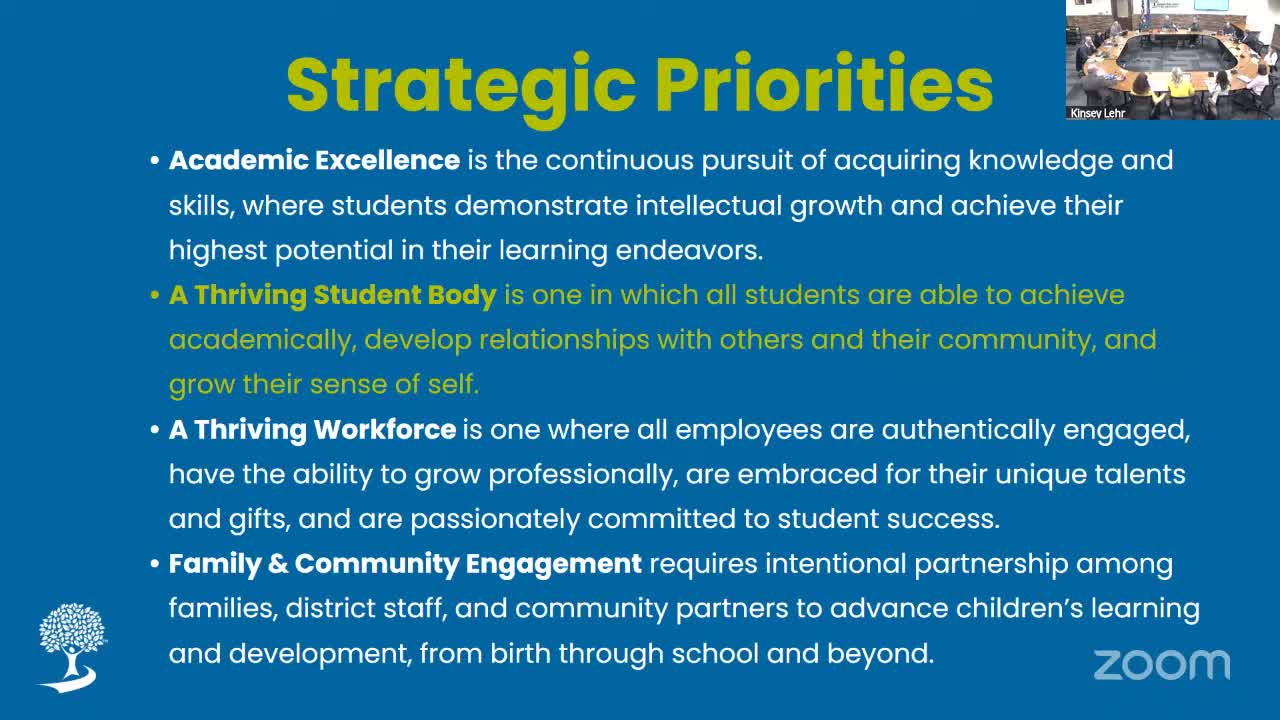District updates strategic goals: boost multilingual graduates and reduce chronic absenteeism
November 11, 2025 | Green Bay Area Public School District, School Districts, Wisconsin
This article was created by AI summarizing key points discussed. AI makes mistakes, so for full details and context, please refer to the video of the full meeting. Please report any errors so we can fix them. Report an error »

Green Bay Area Public School District officials on Nov. 10 presented a strategic-plan progress report focused on two measurable priorities: language proficiency and student attendance.
District presenters said the baseline for students graduating with proficiency in more than one language is 10.25% and staff propose raising the five-year target to 12%. Julie Seefeld, director of multilingual programming, outlined district criteria for counting graduates as proficient in multiple languages, including performance on norm-referenced assessments (for English: ACT ELA composite and AP/IB results; for other languages: AP Spanish, AvantSTAMP for ASL, and approved assessments for other languages). She noted state rules for the Seal of Biliteracy require assessment cut scores (for example, an ACT ELA composite of 18 or an AP score of 3) and that only assessments normed for grades 6–12 count toward the state seal.
District staff said the multiple-pathway approach includes use of AP/IB exams, WIDA exit scores for multilingual learners, early-college credit completion at UW–Green Bay and world-language course completion as evidence of proficiency. Officials emphasized some students who exit multilingual programming in grade 5 do not count toward secondary-grade seals unless assessed in grades 6–12.
On attendance, district leaders set a Year 1 benchmark that at least 73% of students miss fewer than 18 days per school year — the district baseline is 70.5% while the current state rate is 80.2. Christina (associate director of pupil services) said chronic absenteeism is defined as missing 10% or more of the school year (about 18 days) and described a tiered approach: universal strategies (communication and building-level plans), earlier tier-2 interventions targeted at underlying causes, and tier-3 community-partner supports for complex cases. The district announced an upcoming partnership with Attendance Works to join a leadership network and receive 1:1 coaching to support implementation.
Board members asked how bilingual programming continues through middle school, how the district will recruit and retain world-language teachers, and what concrete universal practices schools will adopt; staff said bilingual coursework continues in middle grades at Washington and Edison, emphasized a "grow-your-own" teacher pipeline, and said buildings have autonomy to adopt the universal practices that fit their communities. Staff also said districtwide tactics will include social-media campaigns, parent outreach, school-avoidance training, and leveraging parent-teacher conferences to empower teachers to engage families earlier.
The district plans to return to the board in August to recommend a revised, more ambitious five-year language-proficiency goal after additional data review and to use the 2024–25 report card as a baseline for attendance and graduation measures. The presenters asked the board for input and said they will continue to bring implementation details back to the board for review.
District presenters said the baseline for students graduating with proficiency in more than one language is 10.25% and staff propose raising the five-year target to 12%. Julie Seefeld, director of multilingual programming, outlined district criteria for counting graduates as proficient in multiple languages, including performance on norm-referenced assessments (for English: ACT ELA composite and AP/IB results; for other languages: AP Spanish, AvantSTAMP for ASL, and approved assessments for other languages). She noted state rules for the Seal of Biliteracy require assessment cut scores (for example, an ACT ELA composite of 18 or an AP score of 3) and that only assessments normed for grades 6–12 count toward the state seal.
District staff said the multiple-pathway approach includes use of AP/IB exams, WIDA exit scores for multilingual learners, early-college credit completion at UW–Green Bay and world-language course completion as evidence of proficiency. Officials emphasized some students who exit multilingual programming in grade 5 do not count toward secondary-grade seals unless assessed in grades 6–12.
On attendance, district leaders set a Year 1 benchmark that at least 73% of students miss fewer than 18 days per school year — the district baseline is 70.5% while the current state rate is 80.2. Christina (associate director of pupil services) said chronic absenteeism is defined as missing 10% or more of the school year (about 18 days) and described a tiered approach: universal strategies (communication and building-level plans), earlier tier-2 interventions targeted at underlying causes, and tier-3 community-partner supports for complex cases. The district announced an upcoming partnership with Attendance Works to join a leadership network and receive 1:1 coaching to support implementation.
Board members asked how bilingual programming continues through middle school, how the district will recruit and retain world-language teachers, and what concrete universal practices schools will adopt; staff said bilingual coursework continues in middle grades at Washington and Edison, emphasized a "grow-your-own" teacher pipeline, and said buildings have autonomy to adopt the universal practices that fit their communities. Staff also said districtwide tactics will include social-media campaigns, parent outreach, school-avoidance training, and leveraging parent-teacher conferences to empower teachers to engage families earlier.
The district plans to return to the board in August to recommend a revised, more ambitious five-year language-proficiency goal after additional data review and to use the 2024–25 report card as a baseline for attendance and graduation measures. The presenters asked the board for input and said they will continue to bring implementation details back to the board for review.
View full meeting
This article is based on a recent meeting—watch the full video and explore the complete transcript for deeper insights into the discussion.
View full meeting
